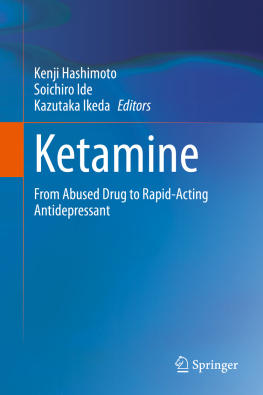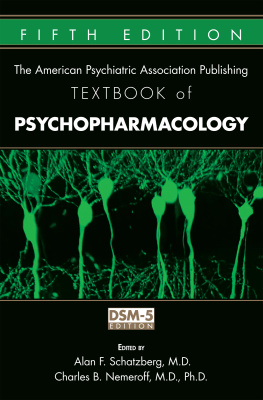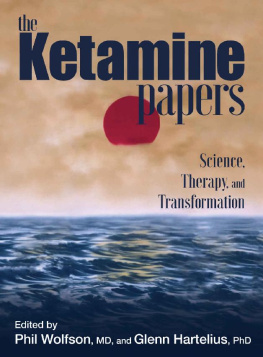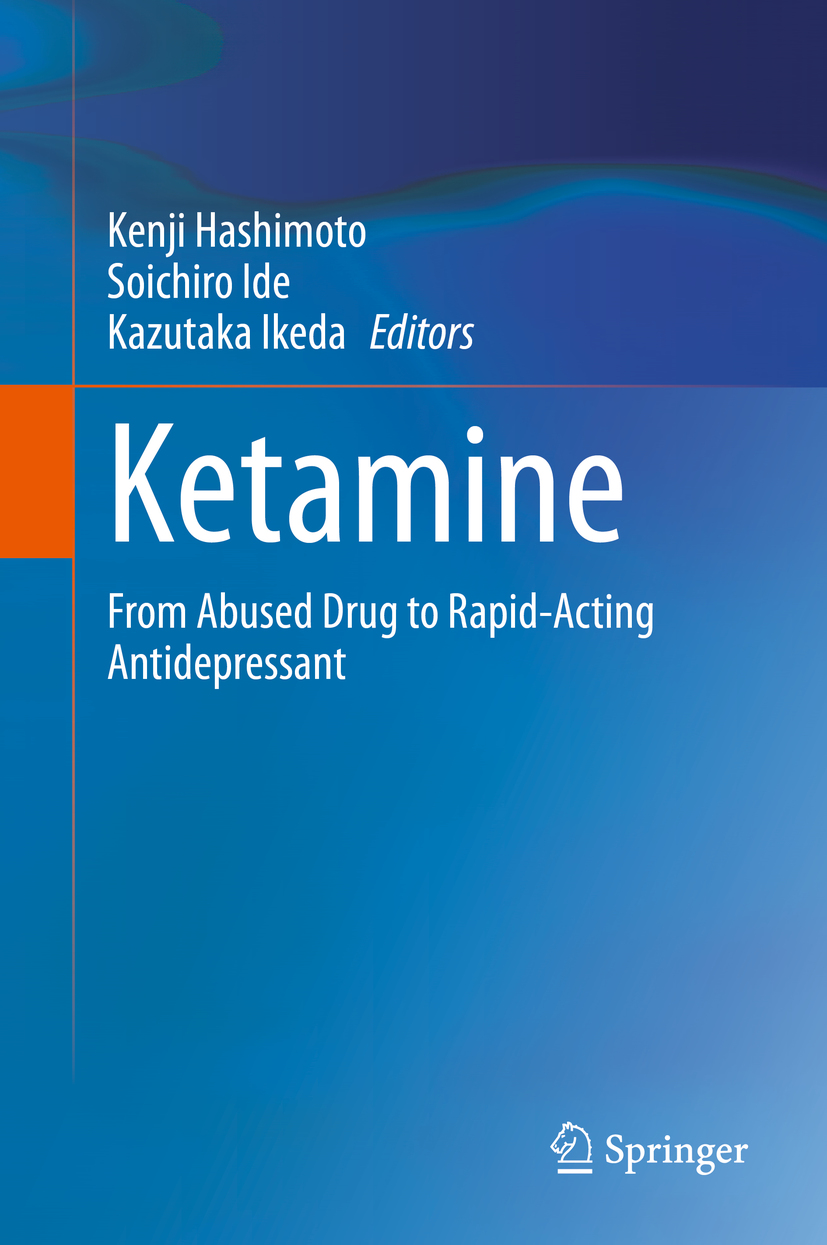Editors
Kenji Hashimoto , Soichiro Ide and Kazutaka Ikeda
Ketamine
From Abused Drug to Rapid-Acting Antidepressant
Editors
Kenji Hashimoto
Division of Clinical Neuroscience, Chiba University, Chiba, Japan
Soichiro Ide
Tokyo Metropolitan Institute of Medical, Tokyo, Japan
Kazutaka Ikeda
Tokyo Metropolitan Institute of Medical, Tokyo, Japan
ISBN 978-981-15-2901-6 e-ISBN 978-981-15-2902-3
https://doi.org/10.1007/978-981-15-2902-3
Springer Nature Singapore Pte Ltd. 2020
This work is subject to copyright. All rights are reserved by the Publisher, whether the whole or part of the material is concerned, specifically the rights of translation, reprinting, reuse of illustrations, recitation, broadcasting, reproduction on microfilms or in any other physical way, and transmission or information storage and retrieval, electronic adaptation, computer software, or by similar or dissimilar methodology now known or hereafter developed.
The use of general descriptive names, registered names, trademarks, service marks, etc. in this publication does not imply, even in the absence of a specific statement, that such names are exempt from the relevant protective laws and regulations and therefore free for general use.
The publisher, the authors, and the editors are safe to assume that the advice and information in this book are believed to be true and accurate at the date of publication. Neither the publisher nor the authors or the editors give a warranty, expressed or implied, with respect to the material contained herein or for any errors or omissions that may have been made. The publisher remains neutral with regard to jurisdictional claims in published maps and institutional affiliations.
This Springer imprint is published by the registered company Springer Nature Singapore Pte Ltd.
The registered company address is: 152 Beach Road, #21-01/04 Gateway East, Singapore 189721, Singapore
Contents
Ming-Chyi Huang and Shih-Ku Lin
Yanhui Liao and Wei Hao
Steffi K. K. Yuen and Anthony C. F. Ng
Hisashi Mori
Daisuke Okada
Naoyuki Hironaka
Lijia Chang , Yan Wei and Kenji Hashimoto
Yue Wang , Xiaolin Xu , Ailin Luo and Chun Yang
Xiao-Hui Tang and Jian-Jun Yang
Soichiro Ide and Kazutaka Ikeda
Mu-Hong Chen and Tung-Ping Su
Springer Nature Singapore Pte Ltd. 2020
K. Hashimoto et al. (eds.) Ketamine https://doi.org/10.1007/978-981-15-2902-3_1
Ketamine Abuse: Past and Present
Ming-Chyi Huang
(1)
Department of Addiction Sciences, Taipei City Psychiatric Center, Taipei City Hospital, Taipei, Taiwan
(2)
Department of Psychiatry, School of Medicine, College of Medicine, Taipei Medical University, Taipei, Taiwan
Abstract
Ketamine is an anesthetic derivative of phencyclidine with dissociative, analgesic, and psychedelic properties. It is extensively used as an anesthetic drug in surgical procedures in pediatric, obstetric, and geriatric patients, as well as in veterinary settings. Since its approval for clinical use, the misuse and abuse of ketamine have been reported in scientific journals and in popular media globally, particularly in the last two decades. It has been used as a common club drug in dance, rave, and squat party scenes. Owing to its unique pharmacological properties, ketamine has been used as an antidepressant for the treatment of resistant depression. However, a long-term use of high doses of ketamine leads to numerous physical and psychological negative effects, such as abdominal pain, urinary system disorder, dependence/tolerance/withdrawal, cognitive impairment, psychosis, and depression. At present, no effective pharmacotherapy for managing compulsive drug-seeking behavior in patients with ketamine use disorder is available. Treatment that incorporates regular urine screening in addition to medications for psychiatric symptoms and craving may present favorable results.
Keywords
Abuse K-hole Physical consequence Psychological consequence Regulation Treatment
Ketamine is an anesthetic derivative of phencyclidine (or N-1-phenyl-cyclohexylpiperidine [PCP]) with dissociative, analgesic, and psychedelic properties. In the 1950s, the staff at Parke-Davis Industries developed two cylcoheximide drugs, PCP and N-ethyl-1-phenylcyclohexylamine chlorhydrate, as ideal anesthetic agents with analgesic effects (Domino ). In this chapter, we discuss ketamine abuse from past to present.
Ketamine Abuse
FDA approved ketamine as an anesthetic in 1970. In the following year, scholars raised the question that if ketamine is a hallucinogen, it may be abused or misused, similar to lysergic acid diethylamide (LSD) (Reier ), scientific reports of the phenomenon were very few until the early 1990s.
Ketamine was not considered a major drug of abuse in the past two decades, and relatively few cases were reported during the period (Hurt and Ritchie ).
The Expert Committee on Drug Dependence of the WHO prereviewed ketamine in 2003 and conducted a critical review in 2006. The committee concluded that this information was not sufficient to warrant scheduling. At a 2012 meeting, the committee decided that bringing ketamine under international control is not appropriate. At the level of the European Union, in 2000, the European Commission concluded that it was not appropriate to introduce control measures and recommended further monitoring of ketamine use. In the latest World Drug Report by United Nations Office on Drugs Control 2019 (UNODC ), ketamine is classified under new psychoactive substances (NPSs), which are not under the control of international drug conventions but which may pose a threat to public health. The growing popularity of ketamine in South-East Asia could be, in part, due to its lower status in regulatory systems and lower price point as a substitute for the increasingly expensive ecstasy or methamphetamine.
In recent years, ketamine has also become commonly abused in Taiwan, particularly among the youth and adolescents (Chen et al. ). In a single drug use episode, MDMA was often the first drug used, followed by ketamine, and then marijuana. This unique sequence of polydrug use in a single episode is called trinity. A long-term use of ketamine may lead to dependence, and this disorder is diagnosed as Other Hallucinogen Use Disorder according to DSM-5 and as Hallucinogen Abuse based on the ICD-10 Code F16.1.
Psychedelic Effects of Ketamine
Contrary to the clinical doses for anesthesia (2 mg/kg) and depression (0.5 mg/kg), the abuse dose is quite high (>3 mg/kg). Most abusers snort ketamine powder directly, and other routes include smoking, ingestion, and rarely injection (Carmona-Huerta et al. ). The relatively rapid onset of the effects on the brain (approximately 5 min) and the short half-life (approximately 12 h) are believed to enhance binging use and the abuse potential of ketamine.
Ketamine is a noncompetitive N-methyl- d -aspartate (NMDA) receptor antagonist. It impairs working, episodic, and semantic memory acutely and causes psychotogenic and dissociative effects in healthy volunteers receiving a single dose. At high doses, ketamine can cause cardiovascular and respiratory toxicity while producing psychotropic effects, which become the primary experience, particularly in recreational users. The effect demonstrates a linear doseeffect relationship ranging from referential ideation, dissociation, and depersonalization to psychotic experiences, including a sensation of feeling light, body distortion, absence of time sense, novel experiences of cosmic oneness, and out-of-body experiences, often referred to as the K-hole (Curran and Monaghan ), the most appealing aspects of ketamine were melting into the surrounding, visual hallucinations, out-of-body experiences, and giggliness, whereas the unappealing effects were memory loss and decreased sociability. A user becomes trapped in a state of detachment from their physical environment and loses senses of time, space, and balance, as well as verbal skills.










